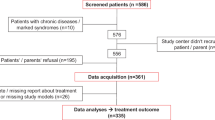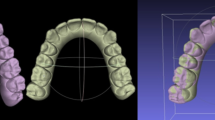Abstract
Aims
The aims of this study were to measure treatment effects of aligner treatments in adult patients directly after treatment and the stability of these effects after a short-term retention period using the Peer Assessment Rating (PAR) Index.
Methods
This double-center trial consecutively screened 98 adult patients of whom 33 patients were treated according to predefined inclusion and exclusion criteria. The study sample was shown to be representative for adult orthodontic reality with regard to gender, age, and distribution of malocclusion type. Malocclusion severity was rated by using the PAR Index measured at baseline (T0), after finishing orthodontic treatment with Invisalign® (T1; Align Technology Inc., Santa Clara, CA, USA) and after a mean retention period of 10 months (T2). Furthermore, to better understand the observed treatment modality, specific treatment characteristics were recorded and analyzed.
Results
The average PAR score at T0 was 22.18 (standard deviation [SD] ± 8.68). Posttreatment PAR score was 4.64 (SD ± 4.23) at T1 and was stable after a retention period of 10.07 months at T2 (SD ± 126.80 days; PAR 4.36, SD ± 3.93). All of the study cases showed a significant reduction of the total PAR score between T0 and T1 (p < 0.001), but no further difference between T1 and T2 (PAR 4.64 vs. 4.36). Cases were either classified ‘improved’ (n = 23) or ‘greatly improved’ (n = 10); no case was classified into the third PAR Index category ‘worse or no different’. On average, 72 aligners (SD ± 22) with 12 attachments per treatment (SD ± 4) were used to align teeth. Six patients needed a case refinement with a mean of 23 (SD ± 8) further aligners. The maximum number of needed ClinCheck® (Align Technology Inc., Santa Clara, CA, USA) treatment plan revisions was 18 (mean 7, SD ± 4).
Conclusion
The detected improvement rate indicated a good standard of orthodontic treatment using aligners. Treatment effects were stable throughout a short-term retention period using a specific retention protocol. Effectiveness and stability were equally achieved in mild, moderate, and rather severe cases within this consecutive sample. A critical focus should be placed on accurate treatment planning in order to make tooth movements predictable, realistic, and stable.
Zusammenfassung
Zielsetzung
Ziele dieser Studie waren zum einen die Behandlungseffektivität von Aligner-Behandlungen erwachsener Patienten mittels PAR(Peer-Assessment-Rating)-Index zu evaluieren und zum anderen die Stabilität dieser Behandlungseffekte zu untersuchen.
Methode
Im Rahmen des Forschungsprojektes wurden 98 Patienten aus zwei Studienzentren konsekutiv gescreent, von denen 33 Patienten gemäß Ein- und Ausschlusskriterien rekrutiert werden konnten. Zahnfehlstellungen und Okklusionsabweichungen wurden mittels PAR-Index vor der entsprechenden Behandlung mit Invisalign® (Align Technology Inc., Santa Clara/CA, USA; T0), nach der aktiven kieferorthopädischen Behandlung (T1) und nach einer durchschnittlichen Retentionszeit von 10 Monaten (T2) ermittelt. Darüber hinaus wurden behandlungsspezifische Details vor Bestätigung erfasst und analysiert.
Ergebnisse
Der durchschnittliche PAR-Summenwert zu T0 betrug 22,18 (Standardabweichung [SD] ± 8.68). Durch die kieferorthopädische Behandlung konnte dieser auf 4,64 (SD ± 4,23) zu T1 reduziert werden und blieb nach 10,07 Monaten zu T2 mit 4,36 stabil (SD ± 3,93). Bei allen Patienten wurde eine signifikante PAR-Index-Reduktion zwischen T0 und T1 (p < 0,001) ermittelt. Zwischen T1 und T2 stellten sich keine signifikanten Veränderungen ein (PAR 4,64 vs. 4,36). Alle Patientenfälle wurden entweder als „improved“ (n = 23) oder „greatly improved“ (n = 10) eingestuft; keine Behandlung fiel in die dritte PAR-Index-Kategorie „worse or no different“. Durchschnittlich 72 Aligner (SD ± 22) mit 12 Attachments (SD ± 4) pro Behandlung wurden zur Begradigung der Zahnfehlstellungen und zur Einstellung der Okklusion genutzt. Sechs Patienten benötigten ein „case refinement“ mit durchschnittlich 23 (SD ± 8) Alignern. Sieben Revisionen des ClinCheck®-Behandlungsplans waren im Mittel vor entsprechender Bestätigung nötig (SD ± 4).
Zusammenfassung
Die vorliegende Studie zeigt, dass ein guter kieferorthopädischer Standard zusammen mit einer hohen Behandlungseffektivität durch Aligner-Behandlungen erzielbar ist. Die Behandlungseffekte waren innerhalb des untersuchten Zeitraums stabil. Ein besonderer Fokus sollte auf einer genauen digitalen Behandlungsplanung liegen, damit entsprechende Zahnbewegungen durch Aligner realistisch erzielbar und stabil sein können.


Similar content being viewed by others
References
Cangialosi TJ, Riolo ML, Owens SE Jr. et al (2004) The ABO discrepancy index: a measure of case complexity. Am J Orthod Dentofacial Orthop 125(3):270–278
Casko JS, Vaden JL, Kokich VG et al (1998) Objective grading system for dental casts and panoramic radiographs. American Board of Orthodontics. Am J Orthod Dentofacial Orthop 114(5):589–599
Clements KM, Bollen AM, Huang G et al (2003) Activation time and material stiffness of sequential removable orthodontic appliances. Part 2: Dental improvements. Am J Orthod Dentofacial Orthop 124(5):502–508
DeGuzman L, Bahiraei D, Vig KW et al (1995) The validation of the Peer Assessment Rating index for malocclusion severity and treatment difficulty. Am J Orthod Dentofacial Orthop 107(2):172–176
Djeu G, Shelton C, Maganzini A (2005) Outcome assessment of Invisalign and traditional orthodontic treatment compared with the American Board of Orthodontics objective grading system. Am J Orthod Dentofacial Orthop 128(3):292–298 (discussion 98)
Grunheid T, Gaalaas S, Hamdan H et al (2016) Effect of clear aligner therapy on the buccolingual inclination of mandibular canines and the intercanine distance. Angle Orthod 86(1):10–16
Gu J, Tang JS, Skulski B et al (2017) Evaluation of Invisalign treatment effectiveness and efficiency compared with conventional fixed appliances using the Peer Assessment Rating index. Am J Orthod Dentofacial Orthop 151(2):259–266
Hennessy J, Garvey T, Al-Awadhi EA (2016) A randomized clinical trial comparing mandibular incisor proclination produced by fixed labial appliances and clear aligners. Angle Orthod 86(5):706–712
Hensel E, Born G, Korber V et al (2003) Prevalence of defined symptoms of malocclusion among probands enrolled in the Study of Health in Pomerania (SHIP) in the age group from 20 to 49 years. J Orofac Orthop 64(3):157–166
Houle JP, Piedade L, Todescan R et al (2017) The predictability of transverse changes with Invisalign. Angle Orthod 87(1):19–24
Khosravi R, Cohanim B, Hujoel P et al (2017) Management of overbite with the Invisalign appliance. Am J Orthod Dentofacial Orthop 151(4):691–699.e2
Kravitz ND, Kusnoto B, BeGole E et al (2009) How well does Invisalign work? A prospective clinical study evaluating the efficacy of tooth movement with Invisalign. Am J Orthod Dentofacial Orthop 135(1):27–35
Krooks L, Pirttiniemi P, Kanavakis G et al (2016) Prevalence of malocclusion traits and orthodontic treatment in a Finnish adult population. Acta Odontol Scand 74(5):362–367
Kuncio D, Maganzini A, Shelton C et al (2007) Invisalign and traditional orthodontic treatment postretention outcomes compared using the American Board of Orthodontics objective grading system. Angle Orthod 77(5):864–869
Lanteri V, Farronato G, Lanteri C et al (2018) The efficacy of orthodontic treatments for anterior crowding with Invisalign compared with fixed appliances using the Peer Assessment Rating Index. Quintessence Int 49(7):581–587
Little RM (1975) The irregularity index: a quantitative score of mandibular anterior alignment. Am J Orthod 68(5):554–563
Littlewood SJ, Millett DT, Doubleday B et al (2016) Retention procedures for stabilising tooth position after treatment with orthodontic braces. Cochrane Database Syst Rev. https://doi.org/10.1002/14651858.cd002283.pub4
Pacheco-Pereira C, Abreu LG, Dick BD et al (2016) Patient satisfaction after orthodontic treatment combined with orthognathic surgery: a systematic review. Angle Orthod 86(3):495–508
Papadimitriou A, Mousoulea S, Gkantidis N et al (2018) Clinical effectiveness of Invisalign(R) orthodontic treatment: a systematic review. Prog Orthod 19(1):37
Richmond S, Shaw WC, O’Brien KD et al (1992) The development of the PAR Index (Peer Assessment Rating): reliability and validity. Eur J Orthod 14(2):125–139
Richmond S, Shaw WC, Roberts CT et al (1992) The PAR Index (Peer Assessment Rating): methods to determine outcome of orthodontic treatment in terms of improvement and standards. Eur J Orthod 14(3):180–187
Schaefer I, Braumann B (2010) Halitosis, oral health and quality of life during treatment with Invisalign and the effect of a low-dose chlorhexidine solution. J Orofac Orthop 71(6):430–441
Shaw WC, Richmond S, O’Brien KD et al (1991) Quality control in orthodontics: indices of treatment need and treatment standards. British Dent J 170(3):107–112
Silvola AS, Rusanen J, Tolvanen M et al (2012) Occlusal characteristics and quality of life before and after treatment of severe malocclusion. Eur J Orthod 34(6):704–709
Simon M, Keilig L, Schwarze J et al (2014) Treatment outcome and efficacy of an aligner technique—regarding incisor torque, premolar derotation and molar distalization. BMC Oral Health 14:68
Solano-Mendoza B, Sonnenberg B, Solano-Reina E et al (2017) How effective is the Invisalign(R) system in expansion movement with Ex30’ aligners? Clin Oral Invest 21(5):1475–1484
Zheng M, Liu R, Ni Z et al (2017) Efficiency, effectiveness and treatment stability of clear aligners: A systematic review and meta-analysis. Orthod Craniofac Res 20(3):127–133
Author information
Authors and Affiliations
Corresponding author
Ethics declarations
Conflict of interest
I. Graf was award recipient of the International Align Research Award by Align Technology, Inc. (Santa Clara, CA, USA). There has been no interfering by Align Technology at any point—not regarding the study planning and study procedures, nor regarding the analyses and presentation of study results. C. Puppe, J. Schwarze, K. Höfer, H. Christ and B. Braumann declare that they have no competing interests.
Ethical standards
The study was approved by the ethics commission of Cologne University’s Faculty of Medicine (NO 15-103).
Additional information
Authors I. Graf and C. Puppe contributed equally to the manuscript.
Rights and permissions
About this article
Cite this article
Graf, I., Puppe, C., Schwarze, J. et al. Evaluation of effectiveness and stability of aligner treatments using the Peer Assessment Rating Index. J Orofac Orthop 82, 23–31 (2021). https://doi.org/10.1007/s00056-020-00249-z
Received:
Accepted:
Published:
Issue Date:
DOI: https://doi.org/10.1007/s00056-020-00249-z




